|

by Gerry Zeitlin
from
OpenSeti Website
|
Note: much of the information on this
page is based on material published by Dr.
Paul LaViolette in 2000. Since
that time, additional pulsars have been catalogued, including
additional eclipsing binary pulsars. This required a recalculation
of the spatial distributions of pulsars and a review of any
conclusions drawn from these distributions.
In November 2005, LaViolette published on his website an
Update on
conclusions presented in The Talk of the Galaxy.
In his update, LaViolette noted that
with 433 newly cataloged pulsars, the "clump" originally seen
adjacent to the Galactic one-radian point is no longer supported.
However, in new discoveries made in
September 2005, the positions of the two fastest pulsars in the sky,
the Millisecond Pulsar and the Eclipsing Binary
Millisecond (EBM) Pulsar, as well as relations between
the period of a new eclipsing binary pulsar which lies in the
vicinity of the one-radian longitude, and that of the Millisecond
Pulsar, all encode the constant p in remarkable ways, supporting the
interpretation that "pulsar beacons" have an extraterrestrial
origin. |
"More than 30 years after
the discovery of pulsars, we still don't know how the
radio waves are produced....
Explaining pulsar radiation is one of the most difficult
problems of astrophysics"
- Prof. Janusz Gil
J. Kepler Astronomical
Center, Zielona G6ra, Poland
As stated earlier, one of the two most
obvious choices for an electromagnetic beacon would be a pulsing
signal with a fixed repetition rate.
A fixed pulse rate would optimize a
receiving civilization's possibility of finding the beacon through
the use of adaptive techniques requiring minimal a priori knowledge
or assumptions. In situations with moderate signal-to-noise
ratios (SNR), the signal would be noticeable even without
advanced receiving techniques. In these cases, the fixed repetition
rate would serve to call attention to the pulse sequence and
possibly even suggest artificiality.
It would be left to the receiving society to aim some directive
antenna in the direction of the signal source in order to maximize
SNR, either as part of an intentional search or accidentally.
In fact, this is exactly what happened in 1967 when Cambridge
University radio astronomers Ms. Jocelyn Bell and Dr. (now
Professor) Antony Hewish discovered first one, and then a second
regular pulsing source in two widely-separated parts of the sky.
Since no pulsing signal sources other than terrestrial man-made ones
had ever been seen before, a strong possibility of ETI-origin was
suspected.
The scientists decided that, if this
proved to be correct, they could not make a public announcement
without checking with higher authorities. There was even some
discussion about whether it might not be in the best interests of
mankind to destroy the evidence and forget it! (Sturrock,
2000)
For Jocelyn Bell's own story of the events, see
Little Green Men, White Dwarfs or Pulsars?
The pulsing signal finding was not published until an
initially-plausible non-ETI interpretation had been constructed:
highly dense compact stars (white dwarf stars) that were somehow
contracting and expanding or dimming and brightening (Hewish et.
al., 1968). In classic scientific tradition, the sources were
labeled "LGM1," "LGM2," etc., the term 'LGM' standing for "Little
Green Men"! 21
But the idea of pulsars (and other newly-discovered astrophysical
objects and phenomena) as ETI beacons must have been circulating
among astronomers.
In a note added to his published
proceedings of a 1971 USSR conference on Communication with
Extraterrestrial Intelligence (CETI),19
Sagan (1973) wrote,
"The very serious current energy
problems both in quasar and in gravity wave physics can be
ameliorated if we imagine these energy sources beamed in our
direction. But preferential beaming in our direction makes
little sense unless there is a message in these channels. A
similar remark might apply to pulsars.
There are a large number of other
incompletely understood phenomena, from Jovian decameter bursts
to the high time-resolution structure of x-ray emission which
might just conceivably be due to ETI. Perhaps, in the light of
Doctor Marx's presentation, we must ask if the fine structure of
some fluctuating X-ray sources is due to pulsed x-ray lasers for
interstellar spaceflight. But Shklovsky's principle of assuming
such sources natural until proven otherwise, of course, holds.
Extraterrestrial intelligence is the explanation of last resort,
when all else fails.31
"The pulsar story clearly shows that
phenomena which at first closely resemble expected
manifestations of ETI may nevertheless turn out to be natural
objects - although of a very bizarre sort. But even here there
are interesting unexamined possibilities. Has anyone examined
systematically the sequencing of pulsar amplitude and
polarization nulls? One would need only a very small movable
shield above a pulsar surface to modulate emission to Earth.
This seems much easier than generating an entire pulsar for
communications.
For signaling at night it is easier
to wave a blanket in front of an existing fire than to start and
douse a set of fires in a pattern which communicates a desired
message."
At about that time, Oliver and Billingham published the influential
Cyclops Report (1972)
containing what I claim to be a flawed justification for dismissing
pulsed signals as probable ETI beacons in place of a search for
monochromatic signals.15
Sagan's suggestion was not taken up by the astronomical community.
Astronomers were unwilling to (publicly) consider an ETI-based
source for the signals they were receiving. One reason they gave (Jastrow
and Thompson, 1977) was that the pulse type of beacon was too
wasteful of energy and wouldn't be the method they would choose.
That was an echo of Oliver's argument. But Oliver aside, refusing to
examine evidence of ETI because the putative ETI behaves oddly is a
commonly-encountered, and thoroughly-unsound, rationale.
Here, the astronomical community was
projecting our own contemporary resource limitations onto unseen and
unknown ETI civilizations. Furthermore, pulsing beacons (as the
Russians knew) are no more wasteful of energy than the monochromatic
kind, given that the civilization on the receiving end employs
matched filters and synchronous detection techniques, as discussed
earlier in this essay. Such receivers would gather energy from the
beacon that had been dispersed throughout the spectrum.
We have often noticed that perfectly-competent scientists lose their
capacity for rational thinking when it comes to the subject of ETI
actually encountered, as opposed to ETI theoretically considered. In
this, scientists reveal their common humanity, and this human race
has a deep fear of such an encounter.
On the subject of a civilization's resource limitations, it would be
well to consider here the classification of civilizations according
to the scale of their access to energy, as proposed originally by
Russian astronomer Nikolai Kardashev and taken up more
recently by
Michio Kaku.
Kardashev and Kaku visualize societies
capable of harnessing the entire energy output of its planet (Type I
society), its star (Type II), and its galaxy (Type III). (We would
be a Type 0.)
For Kaku, a Type III civilization has
access to physics that we would not only not comprehend, but would
not even be able to perceive. One would not have to look very high
in this hierarchy of civilizations to find some for whom the
efficiency of beacons would not be a consideration.
Recently, Sagan's speculations about pulsars as ETI beacons have
been revived in a fascinating book,
The Talk of the Galaxy,
by
Paul LaViolette (2000). With the benefit of years of observations
made since that CETI conference in 1971, LaViolette's analysis makes
an excellent case for seriously reconsidering Sagan's idea.
We will draw a bit from the history of pulsar research that he has
conveniently provided, and outline some of his reasoning and key
points.
The Neutron
Star Lighthouse Model
After the initial two pulsars, many more were discovered, and
continue to be discovered. More than 1100 are known today.
Quite early, the radially-pulsating white dwarf model had to be
discarded as unrealistic when two pulsars with periods less than one
tenth of a second were found in the Crab and Vela supernova
remnants. Out of some twenty different theoretical models that had
been proposed to explain pulsars, astronomers settled on the
"neutron star lighthouse" model proposed by Thomas Gold (1968).
This would be a neutron star emitting
two narrow opposed beams of "synchrotron radiation".35 The pulses
are our perception of the beams as they sweep by us, if we happen to
be in the plane or cone that they sweep out.
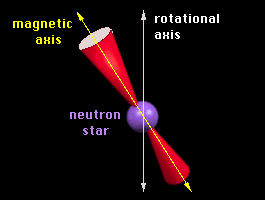
The Neutron Star
Lighthouse Model
Listen to
The Sounds of Pulsars
Gold's neutron star pulsar model was a
congenial development for astronomers because until then no neutron
star had ever actually been observed.
Now there was, provisionally, an
explanation for pulsar signals and confirmation of the existence of
neutron stars, provided subsequent pulsar observations did not cause
any problems with the model. The fact that some neutron stars would
be spinning at a rate of many revolutions per second did not deter
astronomers from continuing to accept and develop the model, even
after pulsars with millisecond periods were discovered.
Pulsar tangential velocities are very high, ranging up to 1/7 c,
which is nearly a relativistic speed and which corresponds to a
monumental centrifugal force. Can mere gravitational forces be
sufficient to keep the object from flying apart? Well, possibly they
can, if the object's mass density is sufficiently high, as the ratio
of gravitational to centrifugal force is proportional to mass
density.
Perhaps the need for an extremely high
mass density is what drove Gold to consider a neutron star
explanation in the first place.
Challenging
Behaviors
But the short periods have not been the only challenge to the
neutron star lighthouse model.
Pulsars have been found to exhibit a
large number of interesting and quite intricate behaviors -
behaviors that (though this may be called post hoc reasoning) fit
much more easily with a model of an ETI beacon carrying information
than they do with any natural-origin model that has been proposed.
Astronomers and astrophysicists have been pushed to the limit as
they contrive more and more intricate neutron star models to explain
what they are seeing, and for some behaviors they have no
explanation.
In 2002, two years after the publication of LaViolette's book,
Kramer et. al., in a paper summarizing the results of
high-resolution single-pulse studies of the Vela Pulsar open with
the statement:
"After more than thirty years of
pulsar observations, the emission mechanism of pulsars is only
poorly understood.”
The paper itself details a taxonomy of
Vela pulsar signal characteristics, with suggestions for trying to
adjust the model to accommodate everything. I think it would be fair
to say, however, that the authors acknowledge unresolved
difficulties in making all the details of the pulsar's
microstructure fit a single model.
For another example of continuing problems in understanding the
physics of pulsars, see the article headlined
Pulsars "Lying About
Their Ages," Astronomers Say, Throwing Theories Into Doubt from the
National Radio Observatory, July 12, 2000. Also (Seiradakis 2000).
These articles describe a supernova remnant now thought to be from
39,000 to 170,000 years old, that has an associated pulsar whose
age, based on the standard method of age determination, is only
16,000 years.
As a news brief in Scientific American
puts it,
"The discrepancy implies that
theories of pulsar formation and the physics of neutron stars
need to be rethought."
Indeed.
Dr. LaViolette enumerates the many problems faced by astronomers in
understanding pulsar signals in terms of their model. He goes into
some details, showing unresolved contradictions, etc.
On this page I
can give only a listing of the key behaviors discussed by LaViolette.
My purpose is to try to convince the reader that there is good
reason for considering an alternative.
Here, then, is the listing:
-
Time-Averaged Regularity;
Single-pulse Variability - Time-averaged pulse contours are
unchanged over days, months, or years. Timing of averaged
profiles is similarly precise. But timing and shape of
individual pulses vary considerably.16
-
Frequency-Dependent Pulse Profiles
- In some pulsars, time-averaged
profile is invariant with observing frequency. In others, shape
and/or number of components in profile changes radically with
frequency (e.g., Crab pulsar).
-
Pulse Drifting (certain pulsars)
- Individual pulses occur successively
earlier and earlier within the averaged profile. For certain
drifting pulsars, drift rate abruptly shifts in value. Or drift
may be random with occasional recurring patterns.
-
Polarization Changes - Polarization parameters vary with
time during individual pulses, in a pattern that itself changes
from pulse to pulse, but the variation of polarization in the
time-averaged profile is constant.
-
Micropulses (ultra-short intensity
variations within individual pulses) - About half of observed pulsars
exhibit micropulses within individual pulses. Micropulses
typically last a few hundred microseconds. Or they may have
oscillatory periods.
-
Pulse Amplitude Modulation - Signal strength may wax and wane
over a series of pulses with period 2 to 20 times longer than
the primary pulse period. The period of this variation can be a
function of the "phase" (position) in the profile or can
correlate with a pulse at a different phase and time lag. This
may be seen only when sampling every other pulse.
-
Fixed Characteristics - Each pulsar’s specific
characteristics of pulse modulation and drifting remain fixed
for years.
-
Pulse Nulling and Freezing - Pulse transmissions may be
interrupted for seconds or up to eight hours. Some studies show
that the pulsar continues to transmit, but at a very low
intensity. During nulling, drift rate becomes exceedingly slow.
When normal transmission is resumed, pulses continue from almost
the exact position in the profile where they had left off!
-
Mode Switching:
-
Frequency-Dependent Mode Switching
- Pulsars with mode switching have
different switching modes, or different numbers of available
modes, at different observing frequencies
-
Mode Switching Grammar. (Example: PSR
0031-07) - There are "bursts" of pulses
separated by null periods. Three pulsation modes are identified:
A, B, and C, with quantized drift rates in the proportion 1:2:3.
Within a burst, mode A may switch to mode B, and B may switch to
C.
-
Period glitching in 21 pulsars
including Crab, Vela - Pulse periods grow at a uniform rate
(as though spinning pulsar is slowing down), but occasionally
the period abruptly changes to a smaller value (pulsar
instantaneously assumes a higher rotation rate?) and the
sequence continues from there, but relaxes over several weeks to
the previous period.
As the reader can imagine, the above is
an extremely brief compilation of the complex behaviors of pulsars.
Each of these behaviors is described in full detail in the
literature. But a key point to keep in mind is that, when averaged
over several minutes or so, these complexities disappear, leaving
only extreme regularity.
That is important when considering pulsars as ETI beacons, because
the regularity over time supports the detection of weak pulsar
signals using matched detection techniques, while the signals
actually can carry information in the small-scale variations.
Once the gross pulsar signal has been
acquired, the receiving civilization can add resources to bring out
the details.
Positions and
Unique Features
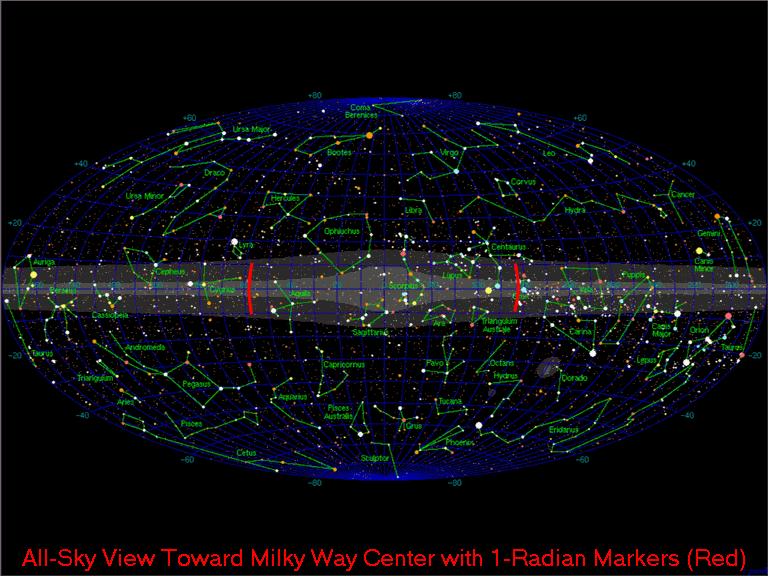
This is an equal-area projection of the
Milky Way in galactic coordinates. North galactic longitude is to
the left. The view shows stars and constellations, not pulsars.
The
distribution of pulsars drops abruptly near 1 radian north of the
Galactic Center - as seen within 53 l.y. from our location. The
profile of supernova remnants does not show this drop-off. There is
an anomalous concentration of pulsars at the south 1-radian point.
The two fastest known pulsars are located at the two points.
The neutron star lighthouse model predicted that pulsars would be
formed in supernova explosions and in fact several of them have been
found near supernova remnants. If that were truly how they were
formed, one would expect to find pulsars concentrated toward the
center of the galaxy where most supernovas occur.
However, LaViolette has noticed that the
distribution of observed pulsars in the galactic plane differs
markedly from that. (He also cites studies of neutron stars
associated with supernova remnants showing that the stars were not
formed in the supernovas.) In fact, there is a clumping of them near
a point one radian to the "north" of the galactic center. There is a
sharp fall-off (2-1/2 fold) of pulsars just beyond that point.
He also noticed that some of the most
unusual pulsars are found right at that edge in the distribution.
Now that is very odd because the distribution of pulsars appears to
concentrate at that point only when seen from near where we are
(within 53 l.y of our location), and there is nothing special about
the place where we are, except for the fact that we are in this
place.
Furthermore, the concentration appears at a position that is very
special.
A radian is, by definition, that angle subtended by the arc
of a circle whose length is equal to the radius of the circle. That
makes the radian a natural (i.e., not arbitrary) unit of angular
measure. A one-radian angle would be meaningful to an intelligent
entity such as a human or a human society or other entity that
thinks the way we do. Entities who think about geometry would most
certainly have thought about this way of measuring angles.
This strongly implies that the pulsars appear where they are by
design, and furthermore that the design is intended to get the
attention of a society that lives exactly where we are.
Does that get your attention? It does for LaViolette and he devotes
a large part of his book to it.
Shall we go on?
Here is the all-sky view with four pulsars shown. These are four of the six known
eclipsing binary pulsars - binaries in whose orbital plane we are
located.
Notice that one each of these pulsars is located at a
1-radian longitude position; the other two are at the Galactic
Center!
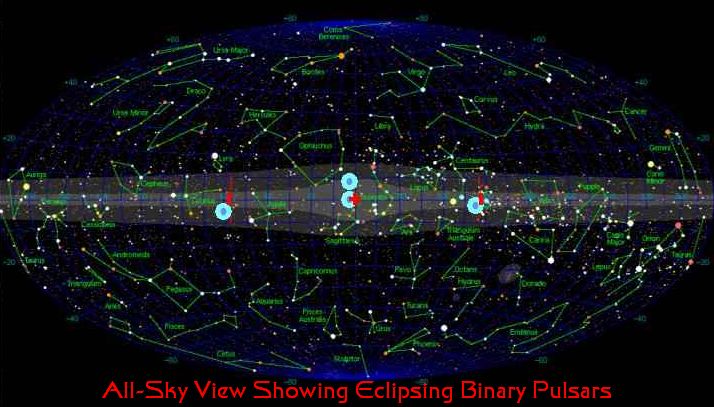
It also happens that the pulsars at the
two 1-radian positions are the two fastest-known-pulsing pulsars!
These pulsars have other unique features that are described by LaViolette, some of which are detailed below. And there is still
much more in his thesis.
To continue, take a closer look at the
north 1-radian position:
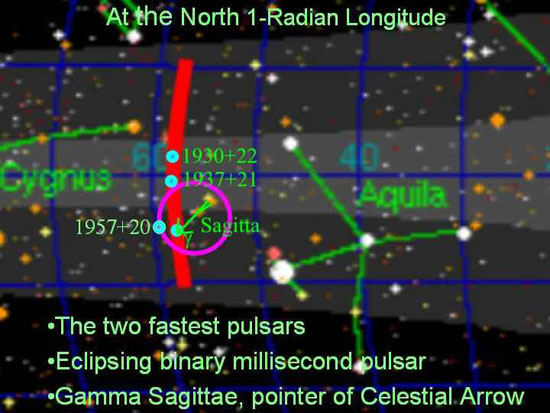
Pulsar 1937-21, the "Millisecond
Pulsar", is the fastest known, flashing 642 times per second.
Its
period is extremely constant at 3.3 x 10-12 sec/yr (better than our
best atomic clocks). This is the most luminous of all millisecond
pulsars with 10-100 times more energy than typical ones. It is one
of only three optical pulsars and the only millisecond optical
pulsar. 1937-21 is one of only two pulsars that emit giant pulses.
And it has the lowest proper motion of any pulsar.
1957-20 is also a millisecond pulsar as well as being the eclipsing
binary mentioned above that is stationed at this point. It is the
second fastest millisecond pulsar, with period just 3% longer than
that of the Millisecond Pulsar. Its period is even more constant, at
0.5 x 10-12 sec/yr.
A third pulsar appears in this little cluster: 1930-22 in the
constellation Vulpecula.
And there is yet another interesting astronomical feature at this
position. Sagitta, the Celestial Arrow constellation, is here, and
Gamma Sagittae, the point of the arrow, is right at 1 radian north
galactic longitude.
Do you think there is any meaning in that?
Well,
hold your opinion until we have discussed the Galactic Center and 1
radian south.
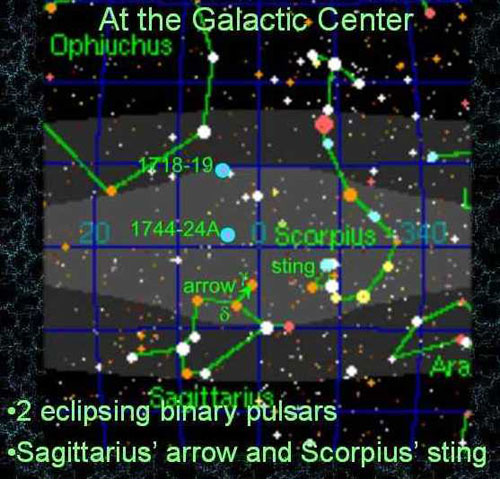
Two of the six known eclipsing binary
pulsars are here: 1718-19 and 1744-24A.
Here is another "arrow
point": that of Sagittarius' arrow, as well as the "sting" of Scorpius.
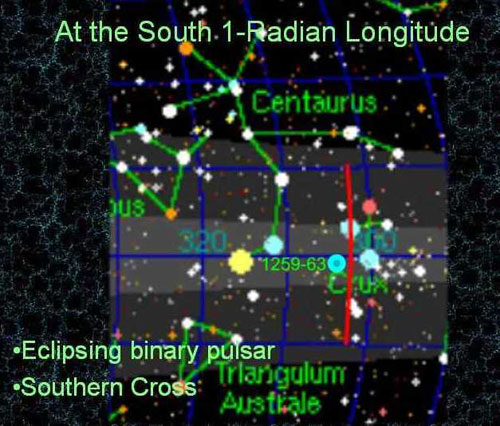
At 1 radian south longitude we find
Pulsar 1259-63, another of the four eclipsing binary pulsars located
at these special positions. (Is there any doubt at this point that
they are special?) The constellation located here is Crux, the
Southern Cross.
Consider now the symbols represented by the constellations or the
particular stars associated with these three positions: Arrow Point,
Arrow Point, Sting, Cross. Each has meaning as a focal point.
Now how might that have come about?
Clearly, "constellations" are arbitrary
groupings of stars in their two-dimensional positions on the
celestial sphere. The symbolic meanings they have been given are
seen by our modern culture as quaint and fanciful products of
simpler and more naive times. How odd, then - how very coincidental
that these particular ones have been given symbolic meanings
associated with pointing out something - something quite invisible
to the stargazers of old.
That is, pulsar with unique qualities,
the (hidden) center of the Milky Way Galaxy, and 1-radian
displacements therefrom, a "radian" itself being a unit of angular
measure not yet thought of, at those times.
What are the implications of all this? How does it happen that very
special objects are located at very special positions, as seen only
by observers located in the vicinity of our solar system?
LaViolette concludes, and at this point
I have no difficulty in supporting him in this, that the pulsars are
there due to someone's intervention. And the almost inescapable
other conclusion is that the constellations were named by beings who
understood what was going on, and who had to mark those positions so
as to draw the attention of a future technological society.
Those
are strong words, but Open SETI is dedicated to paying attention to
evidence of extraterrestrial civilizations, and here we have surely
found such.
At this point we might pause to reflect on the SETI community once
again and their dogged determination to find their idea of an ETI
beacon.
Pulsar
Technology
Is it possible that pulsars could be engineered objects?
Unlike Sagan, who accepted the
conventional model of a pulsar but wondered if ETI could be adding
fine-grained modulation, LaViolette proposes a way in which the
steady emissions of white dwarf or X-ray stars could be focused into
the pulses we see. He explains that ETI might be using projected
magnetic fields to focus the particle flux from these stars into a
nearly-collimated beam of synchrotron radiation. He points to rumors
of present-day military technology that projects force fields and
aerial plasmoids. Sagan's "smoke signal blanket" is retained after
all.
Note that even the neutron star lighthouse model invokes standing
wave magnetic field patterns to modulate the particle flux.
Although we may now have or soon will have the capability to
transmit focused synchrotron beams, LaViolette's transmitting
society has access to energy on a scale far exceeding ours. Although
pulsars are probably not neutron stars, they are still stars - white
dwarfs modified to produce the pulsar signals. The short of it is
that we are observing a Kardashev/Kaku Type II civilization in terms
of its ability to harness the total energy of a star.
Why would we balk at such a proposition? If our physicists can
propose it, should we not accept that we might have found it?
Consider further. The pulsars we detect seem to be intentionally
directed to our location (not just in our direction). But might
there not be beams we don't see that are directed at others?
On the other hand, perhaps they are pointing out our position to
others! (Suggested by Dan Drasin, private communication.)
Whatever may be its purpose, one visualizes at this point a
Galactic-scale communications network that may have been in place
and functioning for what to us would be geologic time.
It would be
operated by a society for whom stars are playthings and galaxies are
villages.
Messages
We have already referred to a kind of message given us by the
pulsars: their meaning by association with constellations named and
defined by we know not who. But surely if these are intentional
transmitters, they themselves must be transmitting information.
In a sense, the zero-order information is that they are there and
they are intentional. This information tells us that there is a
Galactic society.
LaViolette pursues the issue further and discerns a first-order
message as well. But at this point, we will leave the unfolding
story to LaViolette and his book. We will give one hint, however.
One would expect the first-order message to be of Galactic
significance, and this, as divined by LaViolette, it surely is.
LaViolette has looked into the astrophysical aspects of the
association of several pulsars with supernova remnants and seen
something that would be of critical importance to all civilizations
in the Galaxy. Critical, meaning critical to their survival.
For those interested, a concise review of what Dr. LaViolette
believes may be the message of critical importance to civilizations
in our Galaxy (or in any galaxy)
can be found here.
Of course, the ultimate reference to Dr.
LaViolette's ideas is his own
website.
2005 Update
In November 2005, LaViolette updated his discussion of pulsars as
possible ET technology by incorporating data on an additional 433
pulsars that had been located in the
Parkes Multibeam Pulsar Survey.
In the large, LaViolette finds that the
new data support his thesis of ET origin.
See his
Update on conclusions presented
in The Talk of the Galaxy.
Conventional
Searches for Pulsing Signals
For the past several years, the SETI Institute's
Targeted Search System (TSS)
has included algorithms for detecting a variety of pulsing signal in
the final analysis stages of its receivers. This is not, of course,
a search for pulsars. Nor is there even any need at this time to
search for pulsars, for purposes of SETI, as so many of them are
already known.
TSS searches for sets of three regularly-spaced "pulses", where
"pulse" is defined as energy in a frequency bin exceeding some
threshold value.
This constitutes a very crude pulse receiver that
would not be sensitive to a wide variety of "type 2" signals as
described in The SETI Search Space. For one thing, the
generic pulsing signal might consist of very short pulses with
concomitant broad spectra (such as pulsar pulses) whose energy would
mostly be missed by the TSS algorithm. For another, the TSS
algorithm can respond to only a few discrete pulse repetition rates.
The TSS pulsed signal search algorithm is best seen as an
afterthought, tacked onto a receiver designed for monochromatic
signals, and without even any rationale being offered in support of
it.17
NOTES
15 - It could be argued that Oliver's
influential support of the monochromatic signal search paradigm
served to distract most interested persons from consideration of
pulses, let alone pulsars.
16 - In standard terminology, the
time-averaged pulse profile is called the integrated pulse profile.
Individual pulses are called subpulses.
We use LaViolette’s terminology.
17 - A search of 2500 nearby stars
for very short optical pulses is being planned and developed for
UC Berkeley's Leuschner Observatory. And the latest SETI@Home
screensaver now includes a scan for a form of pulsing signal. It
is not clear how these searches were rationalized in view of
SETI's bias in favor of monochromatic searches. Berkeley is also
searching for continuous laser signals.
19 - "Communication with
Extraterrestrial Intelligence", a conference held at the Byurakan
Astrophysical Observatory, Yerevan, USSR, Sept. 5-11, 1971,
sponsored by the U.S. National Academy of Sciences and Akademiia
nauk SSSR. Sagan was reporting on a discussion that took place
between Freeman Dyson, Thomas Gold, Barney Oliver, Marvin Minsky,
Burke, Ginzburg, Sagan, Kardashev, Ozernoy, Francis Crick, Platt,
Phillip Morrison, Lee, and Marx.
21 - The Giggle Factor. Usually accompanied by laughter in a context
that does not appear at all funny. Manifested by SETI scientists and
the nightly news team upon any mention of actual ETI contact.
Psychiatrists call this a defense mechanism. It is used in place of
substantive discussion.
-
Sigmund Freud wrote, "Humor is a defense mechanism that allows
people to face difficult situations without being overwhelmed."
-
See the song Little Green Man by H. Paul Shuch, Ph.D., Executive
Director of The SETI League, SETI humorist.
31 - Sagan throughout his career applied
Shklovsky's principle to all instances of possible indications of
ETI activity. This had the effect of delaying and denying acceptance
of an ETI explanation as long as there was even one natural
explanation that could not be completely eliminated, to his
satisfaction. This is the classic debunker at work, and by playing
on his own public recognition as a "scientist", Sagan blocked the
common person's access to some remarkable possibilities.
35 - Broadband radiation emitted by
electrons traveling at relativistic speeds (or high-energy cosmic
ray particles) when deflected by a magnetic field. Radiation is
confined to a narrow conical beam in the particles' direction of
travel.
|






